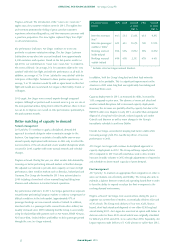Aer Lingus 2011 Annual Report Download - page 20
Download and view the complete annual report
Please find page 20 of the 2011 Aer Lingus annual report below. You can navigate through the pages in the report by either clicking on the pages listed below, or by using the keyword search tool below to find specific information within the annual report.
Annual Report 2011
18
PRINCIPAL RISKS AND UNCERTAINTIES Aer Lingus Group Plc
The Board of Aer Lingus is responsible for the Group’s risk management systems, which are designed to identify, manage and mitigate potential
material risks to the Group’s strategic and business objectives. Safety is of paramount importance, and the management and mitigation of risks
associated with flight safety is the subject of a discrete process, under the control of the Board Safety Committee. Our safety process is described
on page 27.
The corporate risk management process seeks to mitigate the non flight risks faced by the business and is designed to ensure that senior
management are focused on the material risks faced by the Group. After identification, each such risk is assessed in terms of its impact on the
business should it occur, and the likelihood of occurrence. A risk management plan is then developed, setting out the controls in place and the
additional mitigating actions to be applied. This process is iterative and refreshed periodically. The management of each major risk is subject to
review on a quarterly basis with the internal audit function coordinating the quarterly review, tracking progress against action plans and reporting
to the Board Risk Committee. The Executive Management team formally reassesses the corporate risk register on a quarterly basis to ensure that
new and emerging risks are appropriately captured and evaluated, and that legacy issues which are no longer regarded as significant are removed.
The principal risks facing the Group are described below. This is not intended to be an exhaustive analysis of the risks which may arise in the
ordinary course of business or otherwise.
PRINCIPAL RISKS AND UNCERTAINTIES
Risk Impact Mitigation
Economic Our revenues and passenger numbers are very sensitive to
conditions economic conditions in the markets in which we operate.
Weakness in the Irish market in particular, but also in the
UK, continental European or North American economies
can have a significant negative impact on passenger
volumes and fares. The effect would be compounded by
the group’s high fixed cost base. Sustained weakness in
these markets could damage the group’s profitability, cash
flows and ability to grow to the possible detriment of the
Group’s attractiveness as an investment for shareholders.
Partnerships and Aer Lingus is not a member of any of the three global
alliances alliances but nonetheless derives substantial passenger
revenues from its relationships with other airlines. These
airlines are typically members of one of those three global
alliances. The revenues make a very material contribution
to the Group’s fixed costs. If at some future time these
alliances were to restrict such relationships to their own
members, or if the relationships were to be discontinued
for other reasons, Aer Lingus could face the loss of
significant revenue and profit.
Increased The Group’s markets are very competitive but, in general,
Competition no airline appears at present to have significant surplus
capacity on any of our principal routes. If a new
competitor were to enter any of our major markets, and in
particular our transatlantic routes, additional capacity and
the resulting competition for passengers could result in
lower fares and damage the Group’s profits.
The Board reviews booking patterns and revenue forecasts
on a regular basis and takes action when necessary to
maintain an appropriate match between capacity and
demand in the Group’s markets. The Group attempts to
compensate for weakness in the core Irish market by
competing for inbound traffic and by using its relationships
with other airlines, including Aer Lingus Regional, to flow
transfer passengers through its network.
Aer Lingus invests significant management time and effort
in fostering these relationships. Were the alliances to
become “exclusive” in the future, Aer Lingus could seek
membership of one of them, but would need to weigh the
revenue benefits that would accrue against the costs of
membership.
The Group monitors the schedules and intentions of its
current and likely future competitors. In the event that
future competition rendered any of its routes uneconomic,
the Group would consider reductions in capacity to restore
profitability.
























